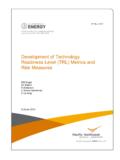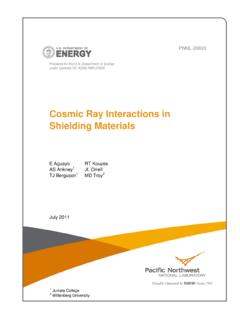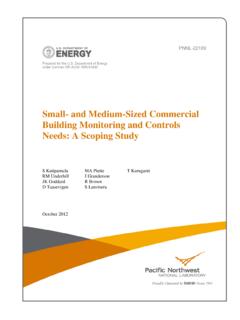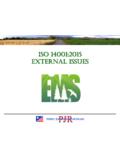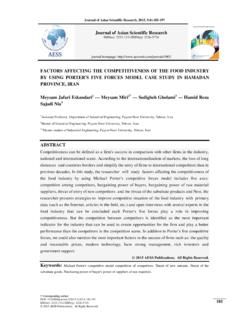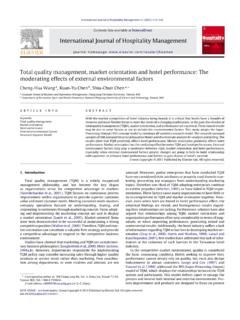Transcription of Consequences of Current Design Practices for LEDs
1 Lumen Maintenance and Light Loss factors : Consequences of Current Design Practices for LEDsSeptember 2013 Prepared for:Solid-State Lighting ProgramBuilding Technologies ProgramOffice of Energy Efficiency and Renewable Department of EnergyPrepared by:Pacific Northwest National Laboratory Lumen Maintenance and Light Loss factors : Consequences of Current Design Practices for LEDs Michael Royer September 2013 PNNL-22727 Abstract Light loss factors are used to help lighting systems meet quantitative Design criteria throughout the life of the installation, but they also carry ancillary Consequences such as influencing first cost and energy use. As the type of light sources being specified continues to evolve, it is necessary to carefully evaluate the methods used in calculating light loss factors , as well as understand the broad effects of performance attributes like lumen maintenance during the selection process.
2 Because of the unique operating characteristics of LEDs and lack of a comprehensive lifetime rating as well as the problematic relationship between lifetime and lumen maintenance determining an appropriate lamp lumen depreciation (LLD) factor for LED products is difficult. As a result, a unique solution has been advocated: when quantity of light is an important Design consideration, the IES simply recommends using an LLD of not greater than This method deviates from the typical practice for conventional sources of using the ratio of mean to initial lumen output, and can misrepresent actual performance, increase energy use, and inhibit comparisons between products. This paper discusses the complications related to LLD and LEDs, compares the performance of conventional and LED products, and examines alternatives to the Current recommended approach for determining LLDs for LED products.
3 Keywords Lamp lumen depreciation, light loss factor, solid-state lighting, light-emitting diode (LED), energy savings1 1. Introduction Light Loss factors A basic goal of lighting Design is to meet the needs of end users over the life of an installation. One element of that goal is producing the desired amount of light. However, unless otherwise adjusted, all lighting systems decline in lumen output over time due to reductions in lamp emissions and changing surface properties lamp, luminaire, and room, if applicable. This decline, as well as other differences between calculations and real-world situations, is typically be accounted for by applying a light loss factor (LLF) during the Design process. In essence, a LLF is a multiplier that is used to predict future performance (maintained illuminance) based on the initial properties of a lighting system. Using a LLF less than , as is typical, means the initial light level will be above the recommended target value, but as time progresses, the light level will decline toward and potentially below the established criterion.
4 The total LLF (LLFT) applied during the calculation process is the product of numerous individual factors . Some of the factors are considered recoverable; that is, they can be changed through maintenance, and generally vary over time. Others are considered non-recoverable; that is, they are factors of the site and equipment, and are generally fixed or unpredictable over time. The IES Lighting Handbook [DiLaura and others 2011] lists three recoverable LLFs: lamp lumen depreciation (LLD), luminaire dirt depreciation, and lamp burnout. Ballast factor is a common non-recoverable LLF. Using a LLF closer to during the Design process has two potential Consequences : (1) the system may not provide enough light as it nears end of useful life; and/or (2) fewer luminaires or lamps with lower lumen output can be used to meet Design targets, effectively reducing the cost of the system.
5 In contrast, using a LLF substantially less than may result in excessive energy use, over lit spaces, glare, light trespass, and/or unnecessary sky glow. Uncertainty in Light Loss factors The difference between actual illuminance depreciation over time, IES-recommended predictive LLFs, and the LLFs (or lack thereof) commonly used by lighting specifiers can sometimes be unclear. This analysis defers to Current IES-recommended Practices as specified in the 10th Edition of the Lighting Handbook [DiLaura and others 2011]. Although IES recommendations are important within the industry, lighting specifiers are ultimately responsible for the methods they use in designing lighting systems. The ability of a designer to use an LLF to accurately predict future performance is limited by several factors . Although many LLFs are empirically based, specifiers must estimate many things, such as the operating cycle or the cleanliness of the environment; often, these attributes depend on the behavior of the occupants or maintenance staff.
6 Further, LLFs approximate average characteristics; variation from installation to installation can create additional uncertainty in predicted performance. Some known causes of light loss, such as environmental and equipment-based thermal characteristics or lamp tilt, are often disregarded by practitioners. In some instances, these disregarded factors are too nebulous to predict accurately and their omission is warranted; nonetheless, they may contribute to differences between predicted and actual performance. Finally, light loss factor calculation methods intended for a group relamping schedule are sometimes applied when spot relamping is utilized, or vice versa. Differences in maintenance can lead to substantial variation in performance over time. 2 Is there more uncertainty for LEDs, as a whole, than conventional sources? One could argue this is true, given that the expected lumen depreciation of LEDs is largely based on predictive models, and further, these models are for LED packages that become components within an integrated LED lamp or LED luminaire.
7 At the same time, it may also be reasonable to conclude that this uncertainty is within the overall slop associated with light loss factors or lighting calculations as a whole and that using predicted LED lumen maintenance is no different from ignoring a tilt factor, thermal factor, or operating cycle for high-intensity discharge (HID) or fluorescent lighting. Further, calculations using conventional sources rely on relative photometry, rather than absolute photometry as used for LED sources; although this does not affect light loss factors , it can influence the accuracy of Design calculations. For example, data from the Department of Energy s CALiPER program has shown the lumen output of luminaires using fluorescent lamps and relative photometry to be overrated by 15% or more when evaluated against absolute photometry measurements [DOE 2009; DOE 2010; DOE 2012].
8 Despite such challenges in accurately predicting future performance, the goal should always be to forecast performance as effectively as possible, following a methodology that is consistent across all types of lighting systems. One of the most important questions that a specifier must consider is whether a lighting system must meet the target illuminance at all times, or if some deviation below the target is acceptable. If some deviation below the target is allowed, how much can be tolerated and for how long? Regardless of the criteria that are chosen, it is important for products to be evaluated under equal conditions. Comparisons and Consequences of Lamp Lumen Depreciation factors This paper examines LLD, a recoverable light loss factor that characterizes the decline in lumen output of a light source over time. For all light sources besides LEDs, LLD is commonly calculated as the ratio of mean to initial lumens [DiLaura and others 2011], where mean lumens are defined as the output at a certain percentage of rated life, based on the lumen depreciation curve for a specific product.
9 In contrast, when quantity of light is an important Design consideration, the IES recommends using an LLD of not greater than for LEDs, regardless of the rated lifetime or lumen depreciation characteristics of the product. This has created a de facto rule-of -thumb LLD of for all LEDs, despite well-documented variation in product performance. This approach hinders specifiers ability to differentiate products based on their lumen maintenance performance, and energy may be used to unnecessarily over-light spaces. Nonetheless, the question remains, Is too low, too high, or just right? [Houser 2012]. The answer is likely dependent on the specific product and the accuracy of Current predictive models, but it is a debate with serious Consequences for responsible energy use. A change in LLD from (resulting in an initial light level at 143% of the target) to (initial light level at 125% of the target) can reduce energy consumption by roughly 13% over the life of the system.
10 With all the effort that is put into improving luminous efficacy in the name of energy efficiency, the effect of LLFs on energy use may deserve more attention, with more care given to using an LLD that best represents expected performance for a given installation. Similarly, while extending rated lifetime may reduce life cycle costs, improving lumen maintenance characteristics can have an immediate impact on both initial and lifetime costs, while saving substantial amounts of energy. At the same time, it is imperative for both specifiers and manufacturers to understand the Consequences of products with poor lumen maintenance 3 characteristics, which require the use of a lower LLD and thus use more energy over the life of the system. 2. Lumen Maintenance Characteristics and Calculations Conventional Sources Generalized lumen maintenance functions for several source types are shown in Figure 1.





